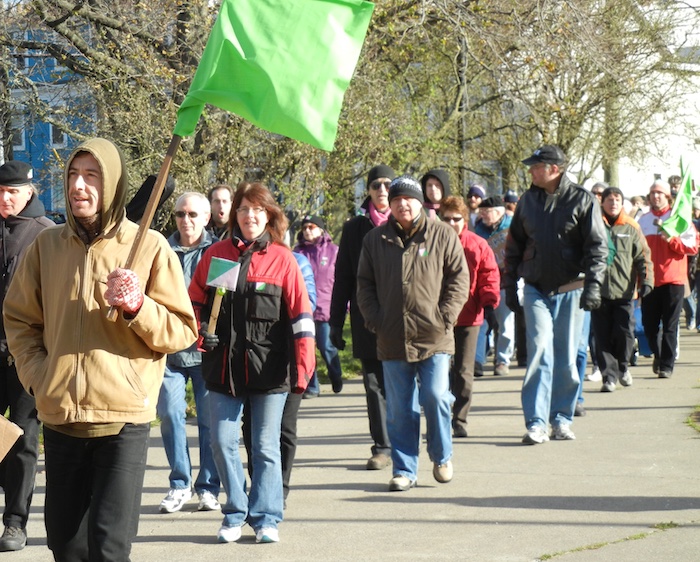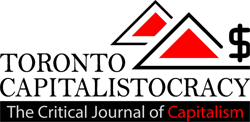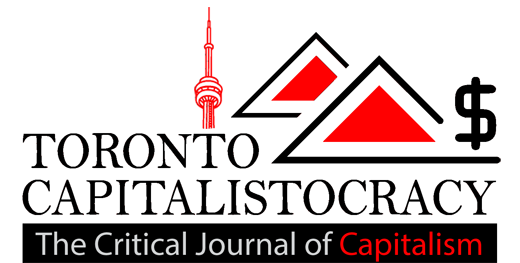Headline News
Inequality, Neoliberalism, and the Unmaking of the Middle Class

Nowadays middle class values largely conform to the neoliberal ideology that has dominated economic discourse for the past 35 years. In light of our current “fiscal” problems, however, maybe it’s time to evaluate whether this has been in our best interests.
In her book Undoing the Demos: Neoliberalism’s Stealth Revolution, Berkeley Professor Wendy Brown argues neoliberalism’s biggest achievement has been to effectively dissolve class solidarity by persuading us to define progress strictly in terms of our individual ability to amass capital or wealth.
Unlike members of the upper class, who can amass wealth simply by manipulating their portfolio of investments, the rest of us have to do it through work. For workers, neoliberalism emphasizes competition, winning and career advancement. Political values such as equality, participatory democracy, unionism and the public good should never get in the way of the mission of what Brown calls “Homo Oeconomicus”, or “Economic Man”.
Who is amassing wealth and who isn’t?
Competitive individualism above all else might conceivably work if there were enough jobs and opportunities around to reward Economic Man. But there aren’t. Too many jobs have gone offshore, and will continue to do so under the trade agreements we keep signing.
As those jobs disappeared, particularly over the last 20 years, something else has been happening. Upper management salaries have exploded into the stratosphere. Big pieces of cheese have been set aside for the 1 percent of workers who, by dint of class background or effort, make it to the top of the industries and services that are left.
The middle class, like the working class of yesteryear, is fracturing. We now have an ever smaller group of “winners” moving upward towards the cheese. On the other side of the fracture, more and more young workers, including those who have “maximized their potential” by getting all the right degrees, are finding they are forced to take part-time, contractual, benefit-less jobs both below and outside of their skill level. They have very little capacity to accumulate wealth.
This assessment of the downside of the fracture seems to stand in stark contrast to a government report, marked secret, which the CBC managed to obtain last week. The headlines ran: “Current Young Generation of Canadians Wealthiest Ever: Federal Study”.
If you simply look at the overall increase in wealth held by young people, the headlines are true. However, according to David McDonald, an economist with the Canadian Centre for Policy Alternatives, a big part of that asset accumulation by the young generation is happening among the offspring of the already wealthy.
“Of all the wealth held by those in their 20s, 70 per cent is held by the top 10 per cent and the bottom 70 per cent hold one per cent of that wealth.”
Perhaps this explains why the government report was secret and the version obtained by the CBC heavily censored.
Universities: the new hotspots of inequality
Universities provide a good example of our new employment order.
Memorial University (MUN) now has a president making nearly $500,000 a year, supported by a sizeable cadre of senior managers who also make big bucks. Contrast that with the well-educated, contractual support staff, many of whom are hired for less than 20 hours a week, presumably so that MUN does not have to pay them benefits.
MUN also has a huge schism between contractual, per-course instructors and tenured professors. Most per-course instructors, even with PhDs, make less than $20,000 a year. The tenured ranks, on the other hand, increasingly include full professors aged well over 65 who make salaries five to eight times that amount. Those in their 70s are also taking in their MUN pensions.
Of course, this is a temporary phenomenon. Once tenured faculty die off, universities will be largely staffed by the precariat. In the U.S. already, only 25 percent of university teaching positions are now tenured.
The democracy deficit in middle class values
Up until the beginning of the 20th century, inequality left both the middle and working classes living in miserable poverty. It was democracy that changed that.
Democracy asserted itself so strongly, not because people were passionate about its philosophical principles. Rather, democracy was embraced because the working class, in particular, understood democratic activism to be the most effective tool they had to attack extreme inequality and maintain a check on the power of elites.
This understanding is being forgotten in the 21st century.
Suggest, as the Occupy Movement did, that you should oppose those who are taking more than their fair share — the investment banks, the corporations, and the 1 percent of the population that run them — and you will be looked at with unease or disapproval.
The middle class’s discomfort with any mention of class conflict with business elites and the 1 percent can’t be simply explained by neoliberalism’s promotion of individual prosperity and upward mobility as the ultimate goal. There’s more to it than that.
Democracy was embraced because the working class…understood democratic activism to be the most effective tool they had to attack extreme inequality and maintain a check on the power of elites.
In Undoing the Demos,Brown meticulously explains the pervasive impact of neoliberal management techniques. The public has been cleverly and subtly persuaded that to spend time addressing problems that are controversial and can’t be quickly resolved is inefficient, unproductive and therefore pointless. The focus should be, instead, on what can be accomplished.
The result of this emphasis on concrete problem-solving of manageable tasks is that complicated political deliberations about justice, values, purposes, class and power—all challenging democratic issues—are extinguished from public conversation. According to Brown, “The effect is to vanquish a vocabulary of power and hence power’s visibility.”
Take a look at the senior high social studies curriculum in Newfoundland and Labrador and you will find courses that include discussion of political and economic problems as they relate to society and the public good are gone. They disappeared in the late ‘90s. Even history has now been marginalized, with the majority of students not taking even one history course during their three years of high school.
The emphasis is now on training 16-18-year-olds to become good workers or good entrepreneurs or good consumers.
As for universities, the focus on training students primarily as workers, managers and market actors has radically changed the mission of institutions for higher learning. As Brown puts it, “Higher education now produces human capital, thereby turning classically humanist values on their head.”
The institutionalization of don’t-talk-politics in schools and universities, coupled with a middle class increasingly lacking both cohesion and memory of class struggles, have led us into what British academic Colin Crouch refers to as “Post-Democracy”.
In our new Post-Democracy world the institutions of democracy are still in place but citizens play a passive, apathetic part. The real politics are shaped in private by interaction between elected governments and economic elites — elites who are not interested in the welfare of the classes beneath them.
Why is this relevant to Newfoundland and Labrador?
At the end of the ‘90s Newfoundland and Labrador was, according to a Statistics Canada report, the least unequal province in Canada.
Our restructuring into an oil economy changed all that.
The suggestions put forth by our business elites on how to solve our current enormous economic problems demand so little sacrifice on their part.
In the first decade of the 21st century, inequality grew faster in Newfoundland and Labrador than in any other province. During the same period, N.L. corporate profits as a percentage of wages leapt to almost three times the national average.
I emphasize the latter point because the suggestions put forth by our business elites on how to solve our current enormous economic problems demand so little sacrifice on their part. Some suggestions, like public private partnerships (P3s), are blatantly full of self-interest.
We shouldn’t really be surprised, though. As Naomi Klein documented so clearly in The Shock Doctrine: The Rise of Disaster Capitalism, crises are a golden opportunity for the elites to capture the nation’s jewels, of which public services are among the most precious.
Isn’t it interesting how in spite of all the evidence documenting how P3s ultimately cost more than publicly-run services, our current government has so quickly been convinced that we must embrace them? The Liberals may have set up a website asking for input on how to address our economic crisis but it’s pretty clear which voices they are choosing to listen to.
So, where do we go from here?
A convincing argument could be made that governments find it natural to favour advice from business elites because the general public’s voice is now so feeble. In our province that’s the consequence of preferring strong leaders to public participation in politics.
It’s time to rethink that preference. Our economic pie has severely shrunk, and we ought to be very nervous about who is going to get the pieces and who is going to end up with the crumbs.
This should be a time for great public vigilance and democratic activism.
Unfortunately, that’s not a valued middle class trait.
Headline News
How Canadian churches are helping their communities cope with the wildfires

As wildfires burn across Canada, churches are finding ways to support their members and the broader community directly impacted by the crisis.
According to the Canadian Interagency Forest Fire Centre, as of June 13, there are 462 active fires across Canada – and 236 of them classified as out of control fires.
Whether it’s through phone calls or donations to community members, here’s how a few churches across Canada are handling active wildfires and the aftermath in their regions.
Westwood Hills, N.S.: St. Nicholas Anglican Church
In Nova Scotia, St. Nicholas Anglican Church and other churches in the area are collecting money for grocery cards to give to families impacted by the Tantallon wildfire.
Right outside of Halifax, N.S., the Tantallon wildfire destroyed 151 homes. More than 16,000 people evacuated the area due to the fire.
The fire is now considered contained, but Tanya Moxley, the treasurer at St. Nicholas is organizing efforts to get grocery gift cards into the hands of impacted families.
As of June 12, four churches in the area – St. Nicholas, Parish of French Village, St Margaret of Scotland and St John the Evangelist – raised nearly $3,500. The money will be split for families’ groceries between five schools in the area impacted by the wildfire.
Moxley said she felt driven to raise this money after she heard the principal of her child’s school was using his own money to buy groceries for impacted families in their area.
“[For] most of those people who were evacuated, the power was off in their subdivision for three, four or five days,” she said. “Even though they went home and their house was still standing, the power was off and they lost all their groceries.”
Moxley said many people in the area are still “reeling” from the fires. She said the church has an important role to help community members during this time.
“We’re called to feed the hungry and clothe the naked and house the homeless and all that stuff, right? So this is it. This is like where the rubber hits the road.”

Headline News
Is it ever OK to steal from a grocery store?

Mythologized in the legend of Robin Hood and lyricized in Les Misérables, it’s a debate as old as time: is it ever permissible to steal food? And if so, under what conditions? Now, amid Canada’s affordability crisis, the dilemma has extended beyond theatrical debate and into grocery stores.
Although the idea that theft is wrong is both a legally enshrined and socially accepted norm, the price of groceries can also feel criminally high to some — industry data shows that grocery stores can lose between $2,000 and $5,000 a week on average from theft. According to Statistics Canada, most grocery item price increases surged by double digits between 2021 and 2022. To no one’s surprise, grocery store theft is reportedly on the rise as a result. And if recent coverage of the issue rings true, some Canadians don’t feel bad about shoplifting. But should they?
Kieran Oberman, an associate professor of philosophy at the London School of Economics and Political Science in the United Kingdom, coined the term “re-distributive theft” in his 2012 paper “Is Theft Wrong?” In simplest terms, redistributive theft is based on the idea that people with too little could ethically take from those who have too much.
“Everybody, when they think about it, accepts that theft is sometimes permissible if you make the case extreme enough,” Oberman tells me over Zoom. “The question is, when exactly is it permissible?”
Almost no one, Oberman argues, believes the current distribution of wealth across the world is just. We have an inkling that theft is bad, but that inequality is too. As more and more Canadians feel the pinch of inflation, grocery store heirs accumulate riches — Loblaw chair and president Galen Weston, for instance, received a 55 percent boost in compensation in 2022, taking in around $8.4 million for the year. Should someone struggling with rising prices feel guilty when they, say, “forget” to scan a bundle of zucchini?

Headline News
The homeless refugee crisis in Toronto illustrates Canada’s broken promises

UPDATE 07/18/2023: A coalition of groups arranged a bus to relocate refugees to temporarily stay at a North York church on Monday evening, according to CBC, CP24 and Toronto Star reports.
Canadians live in a time of threadbare morality. Nowhere is this more obvious than in Toronto’s entertainment district, where partygoers delight in spending disposable income while skirting refugees sleeping on sidewalks. The growing pile of luggage at the downtown corner of Peter and Richmond streets resembles the lost baggage section at Pearson airport but is the broken-hearted terminus at the centre of a cruel city.
At the crux of a refugee funding war between the municipal and federal governments are those who have fled persecution for the promise of Canada’s protection. Until June 1, asylum seekers used to arrive at the airport and be sent to Toronto’s Streets to Homes Referral Assessment Centre at 129 Peter St. in search of shelter beds. Now, Toronto’s overcrowded shelter system is closed to these newcomers, so they sleep on the street.
New mayor Olivia Chow pushed the federal government Wednesday for at least $160 million to cope with the surge of refugees in the shelter system. She rightly highlights that refugees are a federal responsibility. In response, the department of Immigration, Refugees, and Citizenship Canada points to hundreds of millions in dollars already allocated to cities across Canada through the Interim Housing Assistance Program, while Ontario says it has given nearly $100 million to organizations that support refugees. But these efforts are simply not enough to deliver on Canada’s benevolent promise to the world’s most vulnerable.
The lack of federal generosity and finger-pointing by the city has orchestrated a moral crisis. It’s reminiscent of the crisis south of the border, where Texas governor Greg Abbott keeps bussing migrants to cities located in northern Democratic states. Without the necessary resources, information, and sometimes the language skills needed to navigate the bureaucratic mazes, those who fled turbulent homelands for Canada have become political pawns.
But Torontonians haven’t always been this callous.
In Ireland Park, at Lake Ontario’s edge, five statues of gaunt and grateful refugees gaze at their new home: Toronto circa 1847. These statues honour a time when Toronto, with a population of only 20,000 people, welcomed 38,500 famine-stricken migrants from Ireland. It paralleled the “Come From Away” event of 9/11 in Gander, N.L., where the population doubled overnight, and the people discovered there was indeed more than enough for all. It was a time when the city lived up to its moniker as “Toronto, The Good.”
Now, as a wealthy city of three million people, the city’s residents are tasked with supporting far fewer newcomers. Can we not recognize the absurdity in claiming scarcity?





